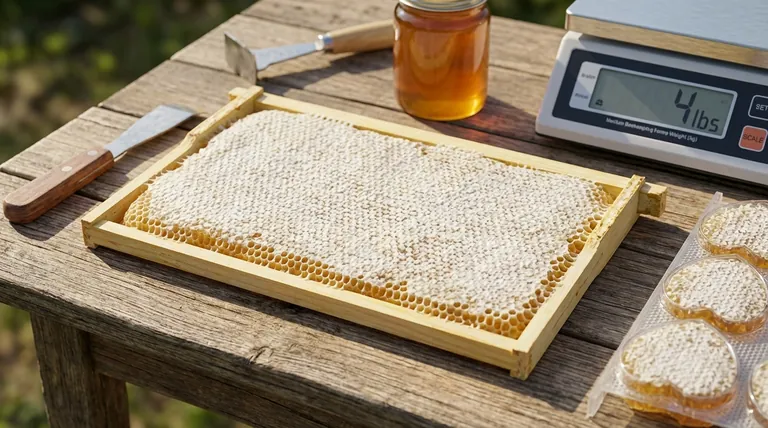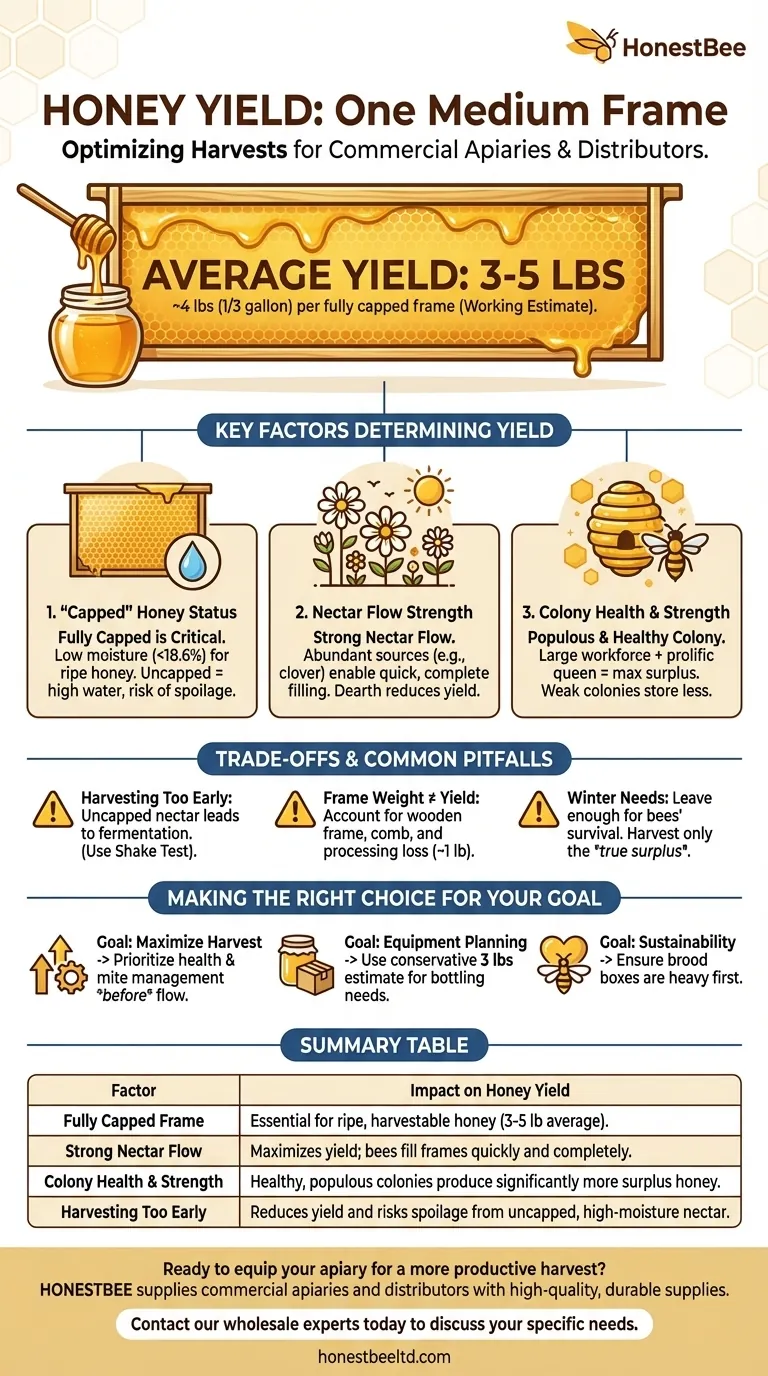On average, a single, fully capped medium frame will yield between 3 and 5 pounds of honey. Most beekeepers use a working estimate of around 4 pounds (or roughly one-third of a gallon) per frame when planning their harvest. This number, however, is not a guarantee and can fluctuate significantly based on several key factors.
The question isn't just how much honey a frame holds, but why that amount varies. Understanding the factors from nectar flow to colony health is the key to managing your expectations and becoming a more effective beekeeper.

What Determines the Yield of a Single Frame?
The 3-to-5-pound range is a reliable guideline, but the final weight of your extracted honey is a direct result of conditions both inside and outside the hive. Thinking in terms of these variables gives you a more accurate picture of your potential harvest.
The Critical Role of 'Capped' Honey
The most important factor is whether the frame is fully capped. Bees place a wax capping over a cell only when the honey inside has been dehydrated to the proper moisture content (below 18.6%).
An uncapped or partially capped frame contains nectar that still has high water content. Harvesting this "green" honey will not only yield less by weight but will also likely ferment and spoil. A truly "full" frame is one that is heavy and almost entirely covered in white wax cappings.
The Impact of Nectar Flow
The availability and quality of nectar in your local environment is paramount. A strong nectar flow from abundant floral sources like clover or basswood will allow bees to fill frames quickly and completely.
Conversely, a nectar dearth (a period with few blooming flowers), poor weather that keeps bees in the hive, or low-sugar nectar sources will result in lighter frames or frames that are never completely filled.
Colony Strength and Health
A large, thriving colony simply has more foragers. A hive with a high population and a prolific, healthy queen will field a massive workforce capable of bringing in significant amounts of nectar.
Smaller or weaker colonies, or those dealing with pests like Varroa mites or diseases, will use most of their resources for survival and brood-rearing. They will store far less surplus honey, directly impacting your harvest.
Understanding the Trade-offs and Pitfalls
Estimating yield is crucial for planning, but a few common mistakes can lead to disappointment or even harm the hive. Objectivity is your best tool.
The Mistake of Harvesting Too Early
The temptation to pull frames that look partially full is strong, especially for new beekeepers. However, harvesting uncapped honey is the most common cause of spoiled batches.
If the honey isn't capped, it's not ready. A simple "shake test" can help: hold the frame over the open hive and give it a firm shake. If liquid nectar flies out, the honey is not yet cured and should be left for the bees to finish.
Confusing Frame Weight with Honey Yield
A full frame weighing 5 pounds will not yield exactly 5 pounds of extracted honey. You must account for the weight of the wooden frame itself and the beeswax comb.
Furthermore, some honey will always be lost during the extraction and filtering process, sticking to the extractor, buckets, and strainers. A practical estimate subtracts about a pound from the frame's gross weight to account for the frame, comb, and processing loss.
Forgetting the Bees' Winter Needs
The most critical trade-off is deciding how much honey to harvest versus how much to leave for the colony. The honey in the hive is the bees' food source to survive the winter.
Taking too much, especially in colder climates, can lead to starvation. A responsible beekeeper always harvests only the true surplus—what is left after the bees have more than enough stored for the non-foraging months.
Making the Right Choice for Your Goal
Your approach to the harvest should align with your primary objective as a beekeeper. Use your understanding of yield to make informed decisions that benefit both you and your bees.
- If your primary focus is maximizing your honey harvest: Prioritize aggressive Varroa mite management and ensure your colonies are populous and healthy before the main nectar flow begins.
- If your primary focus is planning for equipment and bottling: Use a conservative estimate of 3 pounds per medium frame to calculate how many buckets, filters, and jars you will need.
- If your primary focus is bee health and sustainability: Always harvest from the top supers first and ensure the bottom brood boxes are heavy with honey before you take anything for yourself.
By understanding these variables, you can move beyond simple numbers and begin to truly manage your hives for health and productivity.
Summary Table:
| Factor | Impact on Honey Yield |
|---|---|
| Fully Capped Frame | Essential for ripe, harvestable honey (3-5 lb average). |
| Strong Nectar Flow | Maximizes yield; bees fill frames quickly and completely. |
| Colony Health & Strength | Healthy, populous colonies produce significantly more surplus honey. |
| Harvesting Too Early | Reduces yield and risks spoilage from uncapped, high-moisture nectar. |
Ready to equip your apiary for a more productive and efficient harvest?
As a beekeeper, you know that consistent yields depend on healthy bees and reliable equipment. HONESTBEE supplies commercial apiaries and beekeeping equipment distributors with the high-quality, durable supplies needed to support strong colonies and streamline the extraction process.
Let us help you build a more resilient and profitable operation. Contact our wholesale experts today to discuss your specific needs and see how we can support your success.
Visual Guide

Related Products
- Heart-Shaped Comb Honey Frame and Honeycomb Cassette
- Plastic Honey Comb Frames Cassette Box for Honey
- Plastic Bee Frame Beekeeping Hive Frames for Wholesale
- Assembled Wooden Bee Frames with Beeswax Foundation Ready to Use by HONESTBEE
- Assembled Wooden Bee Frames with Plastic Foundation for Durability and Convenience by HONESTBEE
People Also Ask
- How to wire a bee frame? A Step-by-Step Guide for Strong, Durable Honeycomb
- What frame to use for honeycomb? Choose the Right System for Pure, Edible Comb
- What is the bee hive shape called? The Hexagon's Role in Nature's Perfect Storage System
- How should you store prepared bee frames? Protect Your Investment from Pests and Decay
- How much honey from a full frame? Maximize Your Harvest with the Right Frame Size



















